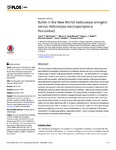Use este identificador para citar ou linkar para este item:
http://www.alice.cnptia.embrapa.br/alice/handle/doc/1062091Registro completo de metadados
| Campo DC | Valor | Idioma |
|---|---|---|
| dc.contributor.author | BENTIVENHA, J. P. F. | pt_BR |
| dc.contributor.author | PAULA-MORAES, S. V. | pt_BR |
| dc.contributor.author | BALDIN, E. L. L. | pt_BR |
| dc.contributor.author | SPECHT, A. | pt_BR |
| dc.contributor.author | SILVA, I. F. da | pt_BR |
| dc.contributor.author | HUNT, T. E. | pt_BR |
| dc.date.accessioned | 2017-01-30T11:11:11Z | pt_BR |
| dc.date.available | 2017-01-30T11:11:11Z | pt_BR |
| dc.date.created | 2017-01-30 | pt_BR |
| dc.date.issued | 2016 | pt_BR |
| dc.identifier.citation | Plos One, v. 11, n. 2, e0167182, December 2016. | pt_BR |
| dc.identifier.uri | http://www.alice.cnptia.embrapa.br/alice/handle/doc/1062091 | pt_BR |
| dc.description | Abstract: The corn earworm Helicoverpa zea (Boddie) and the old world bollworm Helicoverpa armigera (Hubner) (Lepidoptera: Noctuidae) are allopatric species and occur in important agricultural crops. In maize, both species tend to infest the ear. The introduction of H. armigera in Brazil has created a new scenario, where these Helicoverpa species might cohabit and interact with one another, affecting the prevalence of each species in the agroecosystem, integrated pest management, and insect resistance management. In this study, larval occurrence and proportion of these species in maize was assessed in three regions of Brazil during three crop seasons. Interaction between the species was evaluated in interspecific and intraspecific scenarios under laboratory and field conditions. Helicoverpa zea was predominant in Rio Grande do Sul and the Planaltina, DF (central Brazil). In western Bahia, H. zea was predominant in the first collection, but approximately equal in number to H armigera in the second crop season. Both species exhibit high cannibalism/predation rates, and larval size was the primary factor for larval survival in the interaction studies. Larva of H. zea had higher survival when interacting with H. armigera, indicating that H. zea has an advantage in intraguild interactions with H. armigera in maize. Overall, the results from this study indicate that maize might play a role as a source of infestation or a sink of insecticide or Bt protein unselected H. armigera populations, depending on the H. zea: H. armigera intraguild competition and adult movement in the landscape. | pt_BR |
| dc.language.iso | eng | eng |
| dc.rights | openAccess | eng |
| dc.subject | Lagarta do milho | pt_BR |
| dc.subject | Ocorrencia de larvas | pt_BR |
| dc.subject | Brasil | pt_BR |
| dc.subject | Rio grande do sul | pt_BR |
| dc.subject | Bahia | pt_BR |
| dc.subject | Planaltina | pt_BR |
| dc.title | Battle in the new world: Helicoverpa armigera versus Helicoverpa zea (Lepidoptera: Noctuidae). | pt_BR |
| dc.type | Artigo de periódico | pt_BR |
| dc.date.updated | 2017-02-08T11:11:11Z | pt_BR |
| dc.subject.thesagro | Helicoverpa Zea | pt_BR |
| dc.subject.thesagro | Milho | pt_BR |
| dc.subject.thesagro | Praga de Planta | pt_BR |
| dc.subject.nalthesaurus | Helicoverpa armigera | pt_BR |
| riaa.ainfo.id | 1062091 | pt_BR |
| riaa.ainfo.lastupdate | 2017-02-08 | pt_BR |
| dc.contributor.institution | JOSE P. F. BENTIVENHA, ESALQ, USP; SILVANA V. PAULA-MORAES, UNIVERSITY OF FLORIDA; EDSON L. L. BALDIN, UNIVERSIDADE ESTADUAL DE SAO PAULO; ALEXANDRE SPECHT, CPAC; IVANA F. da SILVA, USP; THOMAS E. HUNT, UNIVERSITY OF NEBRASKA. | pt_BR |
| Aparece nas coleções: | Artigo em periódico indexado (CPAC)  | |
Arquivos associados a este item:
| Arquivo | Descrição | Tamanho | Formato | |
|---|---|---|---|---|
| journal.pone.0167182.pdf | 1,74 MB | Adobe PDF |  Visualizar/Abrir |









